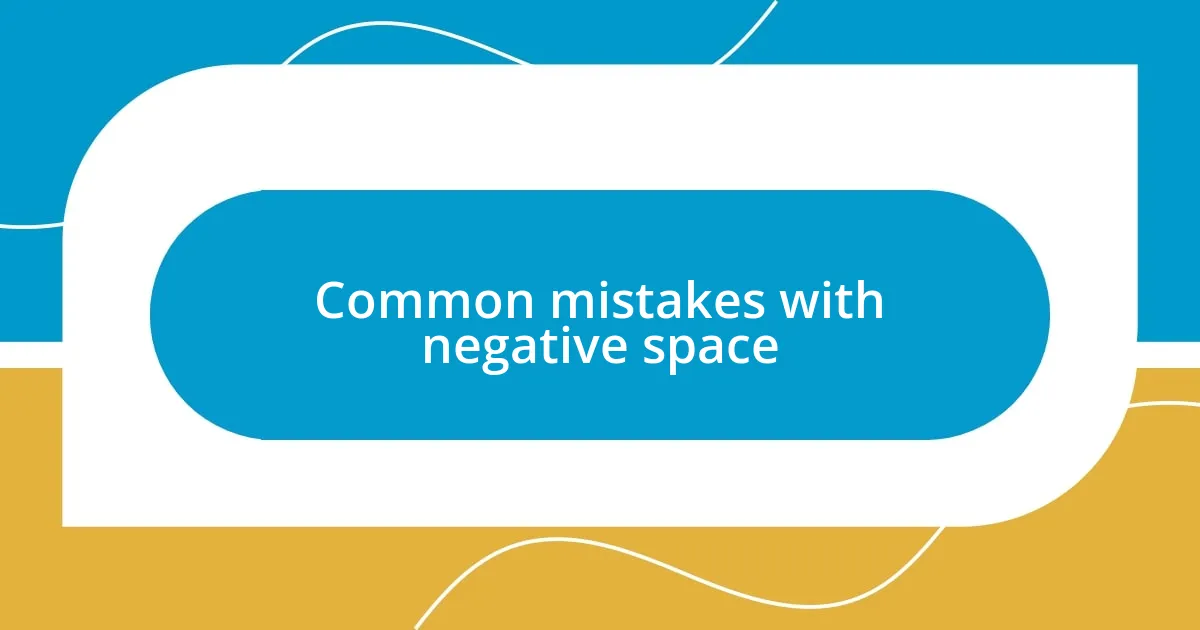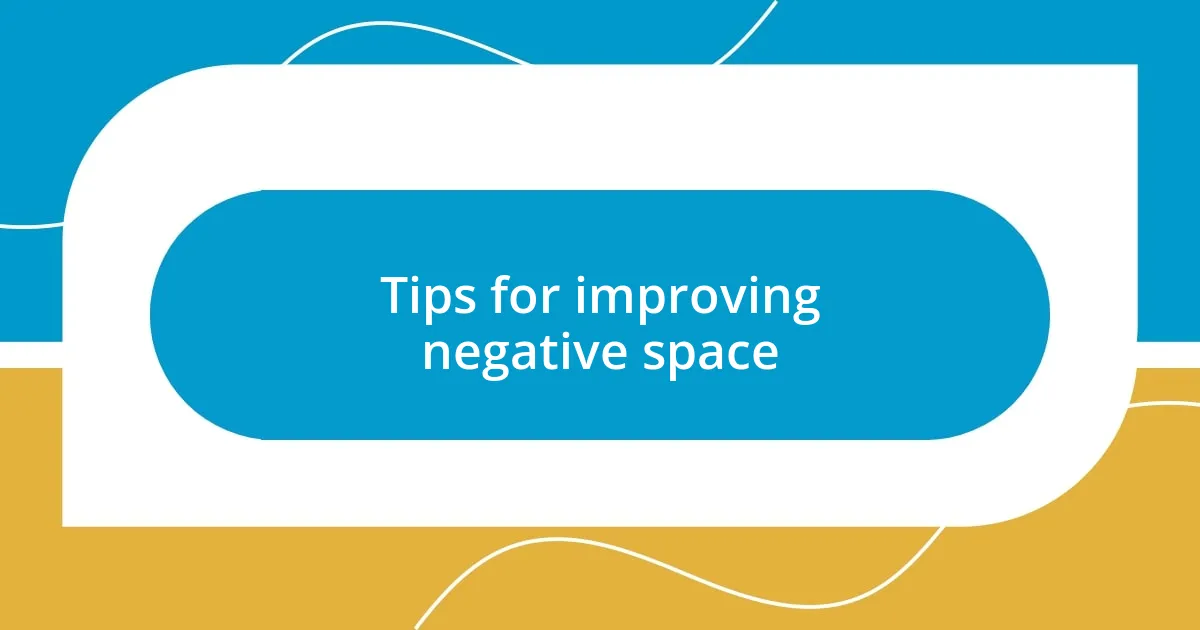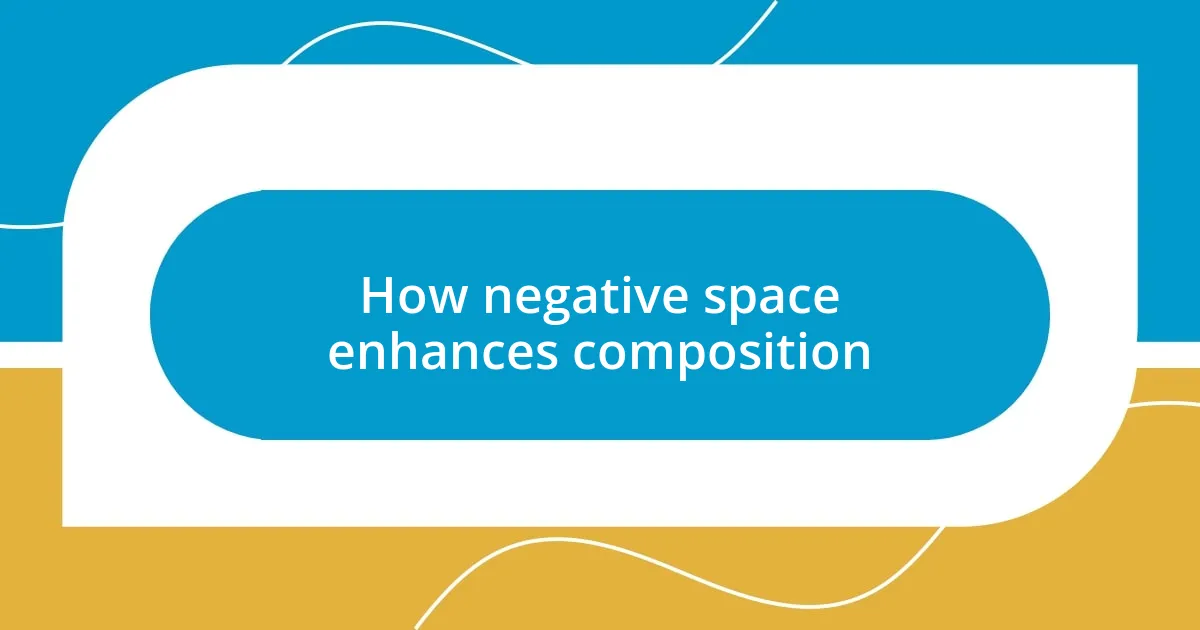Key takeaways:
- Negative space, or white space, is crucial in design as it guides the viewer’s focus and enhances visual clarity, balance, and emotional response.
- Effective techniques for utilizing negative space include framing, hierarchy, and subtraction, which simplify designs and foster user engagement.
- Common mistakes in negative space usage involve overcrowding designs, ignoring proportion, and neglecting the viewer’s experience, leading to confusion rather than clarity.
- Creating intentional negative space encourages storytelling and emotional connections, allowing designs to communicate deeper meanings without overt expressions.

Understanding negative space in design
Negative space, often referred to as white space, is an essential aspect of design that emphasizes the importance of what isn’t there. I remember the first time I stumbled upon the concept while working on a graphic project; I was amazed at how removing certain elements created a focus that truly brought the design to life. Isn’t it fascinating how sometimes, less really can be more?
In my experience, negative space doesn’t just create breathing room; it guides the eye and helps to convey meaning. For instance, when I first designed a logo that utilized negative space cleverly, I felt a sense of satisfaction when viewers recognized the hidden elements. It’s like a little secret that everyone can share in—don’t you love when design invites exploration?
Understanding negative space can shift our perspective on composition. I often ask myself, how does the absence of elements speak in a design? It’s almost as if the negative space has its voice, gently urging our eyes to focus on the subject, while simultaneously delivering a sense of balance and harmony. Through this lens, every design decision becomes a dance between presence and absence, don’t you think?

Importance of negative space usage
Negative space plays a pivotal role in creating visual harmony and can significantly enhance a viewer’s experience. I remember attending an art exhibit where one piece profoundly affected me; the artist used negative space to draw attention to subtle details I might have overlooked otherwise. This technique not only elevated the artwork but also stirred emotions that lingered long after I left. Don’t you think it’s incredible how a simple absence can evoke such powerful reactions?
The strategic use of negative space can simplify complex designs, allowing the main elements to shine without overwhelming the viewer. Reflecting on my own design journey, I often found that less clutter leads to more impactful communication. When I removed extraneous details from a poster I was creating, it almost felt like lifting a weight off the design. The message became clearer, inviting viewers to engage more thoughtfully. Have you ever experienced that moment of clarity when simplicity reigns?
Furthermore, negative space fosters a sense of balance and invites interaction. I recall a project where I incorporated negative space into a website layout. The result was a clean, navigable interface that encouraged users to explore with ease. It’s stunning how effectively negative space can create a welcoming ambiance, prompting users to interact longer. Isn’t it amazing how design can influence our behavior and engagement?
| Aspect | Impact of Negative Space |
|---|---|
| Emotional Response | Evokes feelings of calm and focus |
| Visual Clarity | Simplifies complex designs, enhancing communication |
| User Engagement | Encourages exploration and interaction |

Techniques for utilizing negative space
Recognizing the various techniques for utilizing negative space transforms how we interact with design. During a recent project, I experimented with cropping images more tightly, which resulted in the subject matter breaking free from distractions. It surprised me how a little adjustment in framing could lead to a more focused narrative, compelling viewers to really absorb the essence without a cluttered backdrop.
Here are a few techniques I’ve found effective for leveraging negative space:
- Framing: Use surrounding elements to create natural frames, highlighting the subject.
- Hierarchy: Layer elements with intentional spacing, guiding the viewer’s eye toward focal points.
- Subtraction: Remove unnecessary components to create room for the essential message.
- Contrast: Utilize contrasting colors in negative and positive spaces to accentuate the main elements.
- Shape Play: Explore the shapes formed by negative space, as they can add depth and intrigue to the overall composition.
Another practice I cherish is intentional placement. While designing a flyer, I deliberately left a large section of white space, which caused the text to breathe and come alive. The feedback I received was heartwarming; viewers expressed they felt a sense of calm and order when they looked at it. It’s moments like this that remind me how the absence of detail can cultivate inviting spaces in design that resonate emotionally.

Examples of effective negative space
One of my favorite examples of effective negative space is in the design of the famous FedEx logo. The clever use of negative space forms an arrow between the E and the X, symbolizing movement and speed. Isn’t it fascinating how a simple graphic can convey such a powerful message with just a hint of empty space? Every time I see that logo, I can’t help but appreciate the thoughtfulness behind its creation.
In a personal project, I once created a business card that utilized a lot of open space. I remember feeling anxious at first, worried it might look too bare. However, the feedback I got was eye-opening; people loved how they felt the space allowed them to focus on the key information. It’s intriguing how the right balance can lead to clarity and even give the card a touch of sophistication, don’t you think?
Another striking example is the artwork of Kara Walker. Her silhouettes against stark backgrounds left me in awe during a gallery visit—each piece told a powerful story with just black and white. The negative space didn’t just add depth; it challenged me to confront themes of race and history more directly. I often wonder how many other artists utilize this profound technique to engage viewers emotionally. It’s moments like these that underscore the importance of negative space in art and design.

Common mistakes with negative space
When it comes to negative space, one common mistake is overcrowding the design. I remember the time I designed a social media post and tried to incorporate too many elements. The result? A jumbled mess that left no room for the central message. I learned the hard way that effective negative space requires breathing room, allowing the viewer to grasp the focal point without feeling overwhelmed by visual noise.
Another pitfall many encounter involves ignoring the power of proportion. I once attended a workshop where the instructor showcased designs that misused negative space by making it too small or too large relative to the main subjects. This mismatch completely diluted the intention of the design. The trick is to find that sweet spot—where negative space supports rather than competes with the imagery or text, creating a harmonious balance that draws the eye in.
Lastly, failing to consider the viewer’s experience can be detrimental. I vividly recall a client review session where a beautifully designed flyer fell flat because the negative space wasn’t conducive to easy reading. The text seemed lost in the wider margins, leading to frustration rather than engagement. It’s critical to place the viewer’s perspective at the forefront; after all, the ultimate goal is to create a visual dialogue that speaks clearly and invites interaction.

Tips for improving negative space
Absolutely! Here are some tips for improving negative space, woven with personal insights:
One effective tip is to practice restraint. I remember a design competition where I decided to strip away excess elements, focusing solely on the essentials. The decision to simplify was daunting at first, but the outcome was enlightening. I learned that sometimes, less truly is more, and the strength of the design emerged through the space I initially thought I needed to fill.
Another crucial aspect is to preview your work from a distance. I can’t tell you how many times I’ve zoomed in on details while designing, only to step back and realize my composition felt cramped. Viewing the overall image from afar helps in identifying if the negative space effectively guides the viewer’s eye or if it still feels cluttered. Have you ever had that “aha” moment when stepping back allowed you to see your work in a completely new light?
Lastly, think about grouping related elements strategically. In one of my projects, I clustered items together to create pockets of negative space around them. It was fascinating how this method brought structure and clarity to the design. This simple act not only enhanced the visual flow but also allowed viewers to digest information without feeling overwhelmed. It makes you wonder—how often do we overlook the beauty of space that connects ideas rather than merely separates them?

How negative space enhances composition
Negative space can transform a composition by guiding the viewer’s eye in a deliberate manner. I recall a project where I was tasked with creating an infographic. Initially, I packed in tons of information, attempting to make it as informative as possible. However, it wasn’t until I embraced the idea of negative space that the design really came alive. By intentionally leaving areas of the poster open, I found that the main points stood out more vividly, making the overall message clearer and far more effective.
Another fascinating aspect of negative space is its ability to evoke emotions. During my early design days, I experimented with an advertisement that featured bold images surrounded by ample negative space. What surprised me was how that space lent a sense of calm, making the ad feel more inviting. It’s interesting to question—how might negative space play a role in building a deeper emotional connection with the audience? From my experience, the right balance can evoke curiosity, providing a moment for viewers to pause and absorb the message rather than gloss over it.
Lastly, I’ve discovered that negative space encourages storytelling within a composition. In a recent branding project, I used negative space to hint at the brand’s values rather than overtly stating them. For instance, subtle space around a symbolic graphic allowed viewers to interpret meaning in their own way. It’s a powerful reminder that sometimes, what we don’t say—or show—can be just as impactful as what we do. Isn’t it fascinating how space itself can narrate a story, inviting viewers to form their own connections?














